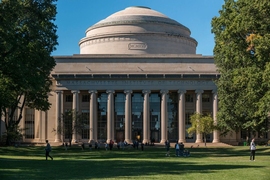The following email was sent today to the MIT community by President L. Rafael Reif.
To the members of the MIT community,
This morning, MIT is launching a major new Institute-wide initiative on human and machine intelligence — the MIT Intelligence Quest, or MIT IQ — and I’m eager to explain why this effort will be crucial as we work to make a better world.
MIT IQ will consist of two parts:
- The Core, which will advance the science of human and machine intelligence, cross-pollinate ideas between the two, spark new collaborations, and engage underlying questions around ethics and societal impact, and
- The Bridge, which will provide custom-built AI tools for MIT researchers in any discipline who do not see themselves as AI experts, to accelerate their research.
You can learn more here about how MIT IQ will fit in and serve our research community.
60 years of intelligent progress
MIT IQ is focused squarely on the future — but it stems from MIT’s distinctive past. Sixty years ago, at MIT and elsewhere, big minds lit the fuse on a big question: What is intelligence and how does it work? The result: An explosion of new fields. Artificial intelligence. Cognitive science. Neuroscience. Modern linguistics. They all took off at MIT — and they have produced remarkable offshoots, from computational neuroscience, to neural nets, to empathetic robots.
The Core
Today, by tapping MIT’s exceptional strength in these and related fields, and by capitalizing on what these disciplines can teach each other, MIT IQ seeks to answer two compelling questions: How does human intelligence work, in engineering terms? And how can we use that deep grasp of human intelligence to build wiser and more useful machines, to the benefit of society?
The foundations of the AI being used now are relatively old. Some major tech firms are advancing true innovations, but most are largely engaged in squeezing brilliant new applications out of existing AI approaches. But the kind of breakthroughs that will revolutionize AI itself require fundamental new science now: a beautiful assignment for a place that loves hard problems. Already this challenge is inspiring interest from forward-looking companies and donors, and we are actively seeking more.
Today, AI is rightly generating both optimism and alarm. It will soon be a dominant source of new wealth, and therefore a new source of inequality, both between nations and within them. A vital element of MIT IQ will be research on AI’s economic, cultural and ethical implications, and how these technologies can be designed from the start to serve the best interests of our whole society. This work has natural links with MIT’s emerging effort to reinvent the future of work; expect to hear more soon.
The Bridge
While the Core pushes frontiers in basic science, the Bridge will accelerate the work of MIT researchers in virtually every discipline, by developing highly specialized AI tools. What’s more, we expect that solving such important practical problems for our own community will spin off new tools with broad impact far beyond our campus.
The best parallel for the Bridge may be Project Athena. In 1983, MIT faced a tough new problem: How to create a campus-wide distributed computing environment to serve the Institute’s educational mission. With a major commitment from leading companies such as IBM, Project Athena enabled MIT faculty and students to master this demanding problem for our community. In the process, they developed new tools — from the X Window System and Kerberos to the early seeds of instant messaging — that helped shape the course of desktop and distributed computing.
By inventing solutions to meet the stringent research demands of our community, the Bridge is positioned to deliver AI innovations for the nation and the world.
With gratitude and admiration
Understanding the nature of intelligence stands as one of the great problems in science; harnessing the forces of machine intelligence to make a better world stands as a defining challenge of our time. As we begin this important work, I want to thank all members of the faculty who poured the expertise and insight of a lifetime into shaping MIT IQ. The momentum you have built is thrilling, and I look forward with admiration to seeing what you achieve.
(And for anyone on campus excited about the quest that lies ahead: From noon to 2 PM today, there will be a little celebration in Lobby 10!)
With excitement and enthusiasm,
L. Rafael Reif







